Worked Example: Manhole covers with an undefined cover shape
In this example we are going to define an
We will make this an auto-action, so that issue features can be automatically created and deleted as their linked features are updated. This means that if a manhole cover is updated to include a defined cover shape then the corresponding issue feature will be deleted, and if a new manhole cover is created with an undefined cover then shape a corresponding issue feature will be created.
-
In order to create issue features, you will need a new layer within your map service or a shapefile or file geodatabase layer to be created that will persist the issue features.
Create an ISSUE layer using the following schema:
Column Name ESRI Type Description OBJECT_ID or FID
Object ID
auto generated ID column by ESRI
SHAPE
Geometry
geometry
OBJECT_REF
Long/Text
store the ID of the real world object which failed the rule
DETAIL
Text
store the name of the rule that the real world object failed
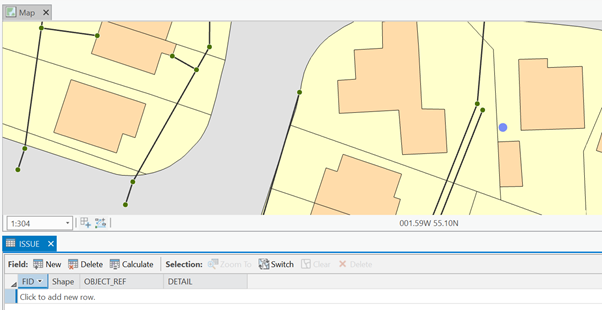
ISSUE layer created in ArcGIS Pro
-
Open the Rule Author.
-
First we must create a simple validation rule to identify the MANHOLE point features.
Create a new rule to check that an attribute called COVER_SHAP is not equal to U (U stands for "unspecified").

Rule to identify Manhole features with an unspecified cover shape
-
Now we must create our Issue Management Quick Action.
Create a new Quick Action and select type Issue Management > Create or Delete Issues.

Create or Delete Issues Quick Action
-
The quick action now requires parameters in order to ensure there is a reference between the features that fail validation and the issue features that are created as a result.
Note: In our example dataset, GLOBALID is the attribute that uniquely identifies the features that fail validation. ISSUE is the name of the layer we created earlier to contain the issue features. OBJECT_REF is the attribute in this layer that uniquely identifies the issue features, and DETAIL is the attribute that lists the rule that the linked feature failed.
Enter the following parameters for the Quick Action:
- ruleReference - (select the rule created earlier)
- objClass - MANHOLE
- objectIdAttribute - GLOBALID
- issueClass - ISSUE
- issueReferenceAttribute - OBJECT_REF
- detailAttribute - DETAIL

Defining the MANHOLE quick action
-
In order for the Issue Management action to appear within the 1Integrate for ArcGIS Add-in or widget, it is necessary to make it an Auto Action. Select the Auto Action toggle from the toolbar at the top of the screen.

Auto-Action toggle
-
Save the Quick Action and publish the associated Ruleset.
-
Open the 1Integrate for ArcGIS Add-in or widget (web application, ArcMap or AcrGIS Pro).
-
Within your Esri application, give your Issue feature class a representation so that when issue features are created, they will be in the symbology / colour you will identify.
-
Open the 1Integrate for ArcGIS Add-in or widget. The Issue Management action will be found in the Enhancement tab.
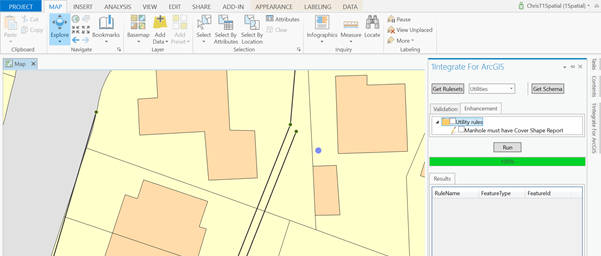
Manhole action displayed in the Enhancement tab
-
Run the enhancement action. If any features fail a rule, then new Issue features will be created.
In our example image below, new issue features have been created on Manhole features where the COVER_SHAP attribute is set to U. The Issue class representation has been set up to be a question mark symbol
 .
.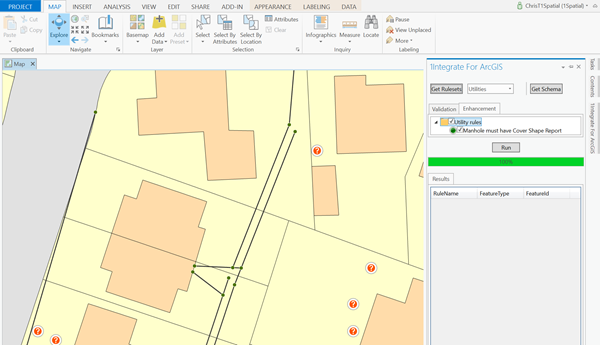
New issue features are created
-
On inspection we can see that the Issue feature contains the information set up in the Issue Management configuration.
It contains the GlobalID of the underlying feature that has failed (OBJECT_REF), and also the name of the rule that has failed (DETAIL).
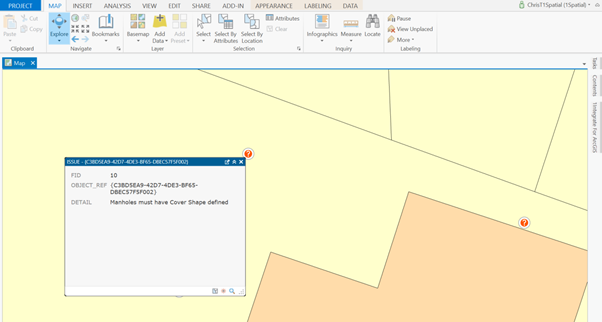
Issue feature attributes
-
If the user then corrects a feature that failed validation (in this case giving the Manhole feature a cover shape) then re-runs the action, Issue Management will automatically delete the Issue feature if it now passes validation.
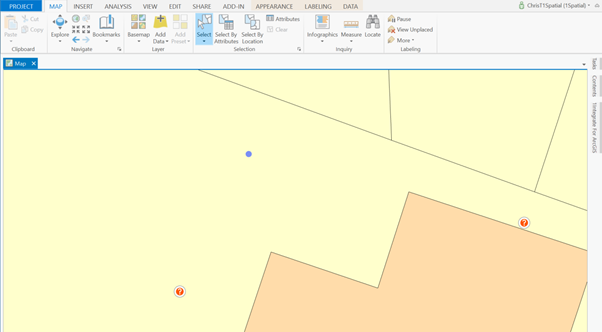
Issue feature removed
Note: If the 1Integrate for ArcGIS Mobile extension is installed, then users do not run the actions through the 1Integrate for ArcGIS Add-in or widget. The Mobile extension can be configured to run rules and actions as soon as anything changes within the map service. When Issue Management is used in this way, then as soon as a user edits features, Issue Management actions are run to determine if issue features need to be created. Similarly when a user corrects a feature, Issue Management will remove issue features automatically without the user having to do anything.

